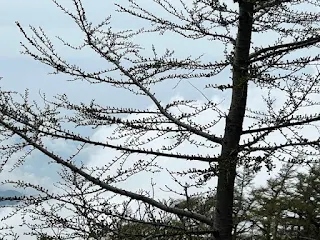First Blog Post: On the way to Japan Tokyo -Day 1
Second Blog Post : On the way to Japan - visiting Fuji-san
Since we had a huge breakfast from the hotel, we chose tempura and a soba noodle soup. Even though it looked very simple, they give you an overwhelming amount of noodles. We chose those because we'd seen them in Japanese TV shows. The tempura included a large langoustine (Norway lobster), broccoli, and two pieces of fried fish. There's chili powder on the table if you want to add some. That's enough then. The presentation is also very important in Japan. We also drank a melon juice. Since we were wearing socks, if we went to the restroom, there were separate slippers to use. Restrooms in places like this in Japan are generally very clean. The picture was taken in front of that place.
A Ryokan is a place, similar to where we went to eat, that offers bathing, dining, and if needed, sleeping facilities, along with saunas and other amenities. It's said that these have existed since around 700 AD.
After that, we were taken to the Hakone Ropeway, also known as the cable car station, or gondola station. From here, we're going up to a station called Soun, which is directly over the Hakone volcano. The cable car, or gondola, can hold about twenty people. The trees and plants on both sides of the path going up really look a bit like Europe. The bottom of the gondola has a glass panel, so you can see straight down.
What appears as fog in the pictures is actually smoke rising from the volcano. This entire area is filled with sulfur gas, and you can smell it – it's like the smell of rotten eggs. The cable car switches at the Owakudani station. The only other place I've seen smoke coming out of the ground like this is in Iceland.
When you go up the mountain, you can eat black eggs that have been cooked or roasted in this smoke. As you ride, Mount Fuji also looks beautiful.
On this route, after seeing Mount Hakone and the steaming vents, we came down to Lake Ashi. This lake is actually a caldera, or a crater formed by a volcanic eruption. It's just like what I saw on Santorini Island in Greece. I've also uploaded this trip to YouTube. This lake is located in the Kanagawa prefecture. The volcano erupted in the year 1170 C.E. There are hot springs all around it.
It's forbidden to enter this lake, or caldera. While it has a depth of between 15 and 45 meters, that's not the reason for the prohibition. The reason is that the water suddenly heats up to over seventy degrees Celsius. About five hundred years ago, a samurai went for a swim. Suddenly, the water became hot. As he swam back from the middle of the lake, he was burned and died. The Shogun who ruled the country then prohibited entry into the water, and that rule is still in effect today.
There are two or three beautifully designed pirate ships available to cruise around the lake.
After that, we arrived at the Odawara train station on the same bus we took earlier. From there, we traveled from Odawara to Tokyo on a Japanese bullet train, specifically a JR Tokaido Line train. Since it travels at speeds of about 250 km/h, we reached Tokyo in about 40 minutes (compared to two and a half hours by bus). During this trip, I noticed how many apartment buildings there are in Japan. The only other time I've seen so many apartment buildings was in the former Soviet Union. These homes are cheap and small, but every building and house is kept very clean.
All the pictures were taken by me.

















































